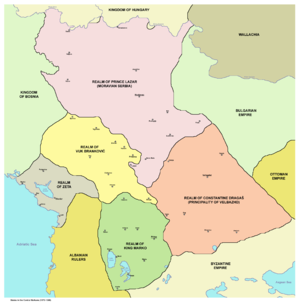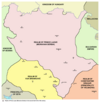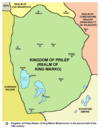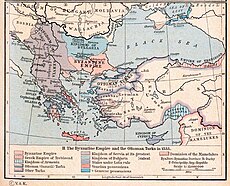Fall of the Serbian Empire
| Fall of the Serbian Empire | |||||||
|---|---|---|---|---|---|---|---|
 | |||||||
| |||||||
The fall of the Serbian Empire was a decades-long process in the late 14th century. Following the death of the childless Emperor Stefan Uroš V in 1371, the Empire was left without an heir and the magnates, velikaši, obtained the rule of its provinces and districts (in so-called feudal fragmentation), continuing their offices as independent with titles such as gospodin, and despot, given to them during the Empire. This period is known as the dissolution or the beginning of the fall of the Serbian Empire.
Between 1366 and 1371,
The period after the death of Uroš and Vukašin (1371–89) was marked by the rise and fall of Prince Lazar, and the power struggle of the minor provinces. Lazar ruled the most powerful Serbian principality, Moravian Serbia. The rule of Lazar ended with his death in the Battle of Kosovo in 1389, when Serbia stood up against invading Ottomans, an event that is deeply rooted in Serbdom. By 1395, most of the southern provinces had been conquered and annexed by the Ottomans, and the provinces of modern Central Serbia had accepted nominal Ottoman rule. Lazar was succeeded by his son, Stefan Lazarević, who ruled the rump Serbian Despotate, which finally fell to the Ottomans in 1459, thus marking the end of the medieval Serbian state.
Stefan Uroš V's rule

Dušan's half-brother
One of the strongest western nobles was
History
Battle of Maritsa
There was a far more serious problem for Serbia — and the whole Balkans — than the internal squabbling of the Serbian nobles, and that was the advance of the
On September 26, 1371, King Vukašin with his brother Despot
Prince Marko inherited the royal title of his father and became the co-ruler of Emperor Uroš.
Death of the Emperor
Stefan Uroš V died childless on December 2/4 1371, after much of the Serbian nobility had been destroyed by the Turks in the Battle of Maritsa earlier that year. Vukašin's son Marko inherited his father's royal title and thus became the disputed successor of the Serbian throne, the nobles pursued their interests, quarrelling with each other.
Real power in northern Serbia was held by
Đurađ II Balšić's edict
In 1372 Đurađ succeeded his father
Plots against Marko
When his father died, "young king" Marko legally became a king and the co-ruler of Tsar Uroš. Soon afterwards came the end of the Nemanjić dynasty, when Uroš died on 2 or 4 December 1371, which formally made Marko the sovereign of the Serbian state. Serbian lords, however, did not even consider to recognize him as their supreme ruler,
After the Battle of Maritsa,
Plot against Nikola
In the spring of 1371, Marko participated in the preparations for a campaign against
In 1371, Đurađ announced to
Assembly of 1374
The Assembly (Sabor) took place on September 26, 1374, symbolically three years since the Battle at Maritsa. The Assembly was held to stop the discord between Serbian nobles. Marko and Lazar both claimed the title of King, with Vuk Branković supporting Lazar.[12]
Crowning of Tvrtko
On 26 October 1377, Tvrtko had himself crowned as Stephen Tvrtko I, by the Grace of God, King of the Serbs, Bosnia and the Seaside and the Western Lands. Today, some historians consider that he was crowned in the
Death of Balšić
Đurađ I died on 13 January 1378 in Scutari. However, recent studies now conclude that Đurađ died in 1379 rather than in 1378. The rule of Zeta was passed down to his younger brother, Balša II. Đurađ's death caused quite a stir between Zeta's neighbours. Bosnian Ban Tvrtko I annexed Đurađ's territories bordering Dubrovnik in 1377, along with the remainder of Đurađ's coastal lands between the Bay of Kotor and the land previously annexed in 1377 at the time of his death. Tvrtko secured these possessions through Đurađ's death, free of the worry of any counter-attack.
Vuk Branković also took this opportunity to gain Đurađ's land. Branković sent his forces into Metohija and seized Prizren, along with the rest of Đurađ's holdings in the region. [16]
Rise of Lazar
"v leto 6889. godine ubi Crep I Vitomir Turke na Dubravci"
"In the summer of 1380, Crep and Vitomir killed the Turks on Dubravnica"
-Lazar's chronicles on his commanders[17]
By 1379, Prince Lazar Hrebeljanović, the governor of
Battle of Kosovo

On 28 June 1389, Serbian forces led by Prince Lazar, Vuk Branković, and Tvrtko's nobleman Vlatko Vuković of Zachlumia, confronted the Ottoman army led by Sultan Murad I and his two sons Bayezid and Yakub. This was the Battle of Kosovo—the most famous battle in Serbia’s medieval history. If the earlier Battle of Maritsa was the beginning of the end of the Serbian Empire, then the Battle of Kosovo less than 20 years later was the death knell. The majority of the Serbian army was obliterated in battle, although it started well for the Serbs; Vuk Brankovic, who led the Serbian right-wing, routed the left wing of the Ottomans being led by another son of Murad, Yakub, after the Serbian heavy cavalry began the battle by hitting the Ottoman left hard and damaging their centre, pushing them back and gaining the initial advantage. Murad's other son, Bayezid, commanded the Ottoman right, which was made up of four Turkish, two Serbian, and one Bulgarian divisions. He held off the forces of Vlatko Vukovic and the Serbian/Bosnian component of the Serbian left. Bayezid, with his reserves fresh and ready for battle, counterattacked Lazar's Serbs, who had been pushing hard against the Ottoman centre. His troops broke through to the wounded Lazar himself, captured him and other Serbian nobles, and took them before the face of Murad, who by this point was dying after being stabbed by a Serbian false deserter, Milos Obilic. Before Murad's death, he watched the beheading of Lazar and the other nobles. While the Serbs then retreated, the Ottoman army also withdrew, due to their heavy casualties, and Bayezid returned to Adrianople to consolidate his hold on his new throne. The battle was a loss for the Serbian prince and his vassals;[21] although they had destroyed most of the opposing force, few Serbian troops remained, while the Turks had many more troops in the east. Consequently, the Serbian principalities that were not already Ottoman vassals soon began to submit in the following years.[22]
The majority of the Serbian army was obliterated in battle;[22] but both Lazar and Murad lost their lives in it, and the remnants of their armies eventually retreated from the battlefield. Furthermore, in response to Turkish pressure,[23] some Serbian noblemen wed their daughters, including the daughter of Prince Lazar, to Bayezid.[24][25] In the wake of these marriages, Stefan Lazarević became a loyal ally of Bayezid, going on to contribute significant forces to many of Bayezid's future military engagements, including the Battle of Nicopolis. Eventually, the Serbian Despotate would, on numerous occasions, attempt to defeat the Ottomans in conjunction with the Hungarians until its final defeat in 1459 and again in 1540.
Administration

| Provinces | ||||
|---|---|---|---|---|
| Map | Name (Territory) | Ruler(s) | Notes | |
 |
Moravian Serbia (Central Serbia) |
Lazar Hrebeljanović Stefan Lazarević |
Ottoman vassal 1390- | |
 |
Zeta Lordship (South Montenegro and northernmost Albania) |
Balšić noble family | . | |
 |
Prilep Lordship (Western North Macedonia) |
Marko Mrnjavčević |
Becomes Ottoman vassal after Maritsa. | |
 |
Domain of the Dejanović family )(Eastern North Macedonia |
Jovan Dragaš Konstantin Dejanović |
Becomes Ottoman vassal after Maritsa. | |
 |
) | Vuk Branković Đurađ Branković |
Ottoman vassal 1392-1396 | |
| Minor / Brief / : | ||||
 |
Altomanović District (Herzegovina, Raška, North Kosovo and Zlatibor) |
Nikola Altomanović | District conquered by neighbouring nobles by 1373. | |
Legacy
See also
| History of Serbia | |
|---|---|
 | |
| 1071–1217 | |
| Kingdom of Serbia | 1217–1346 |
| King Dragutin's realm | 1282–1325 |
| 1346–1371 | |
| Lordship of Prilep | 1371–1395 |
| Prince Lazar's Serbia | 1371–1402 |
| Vuk's Land | 1371–1412 |
| Despotate of Serbia | 1402–1537 |
